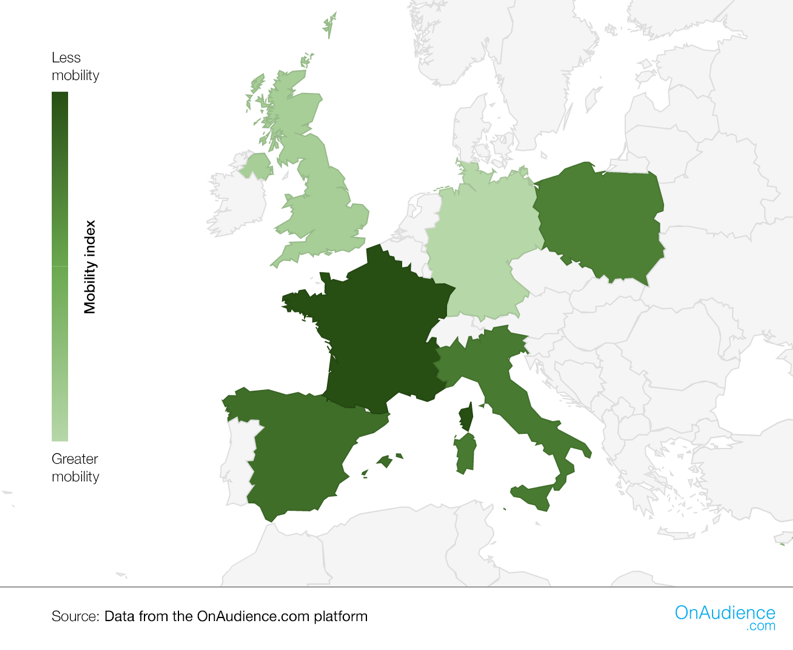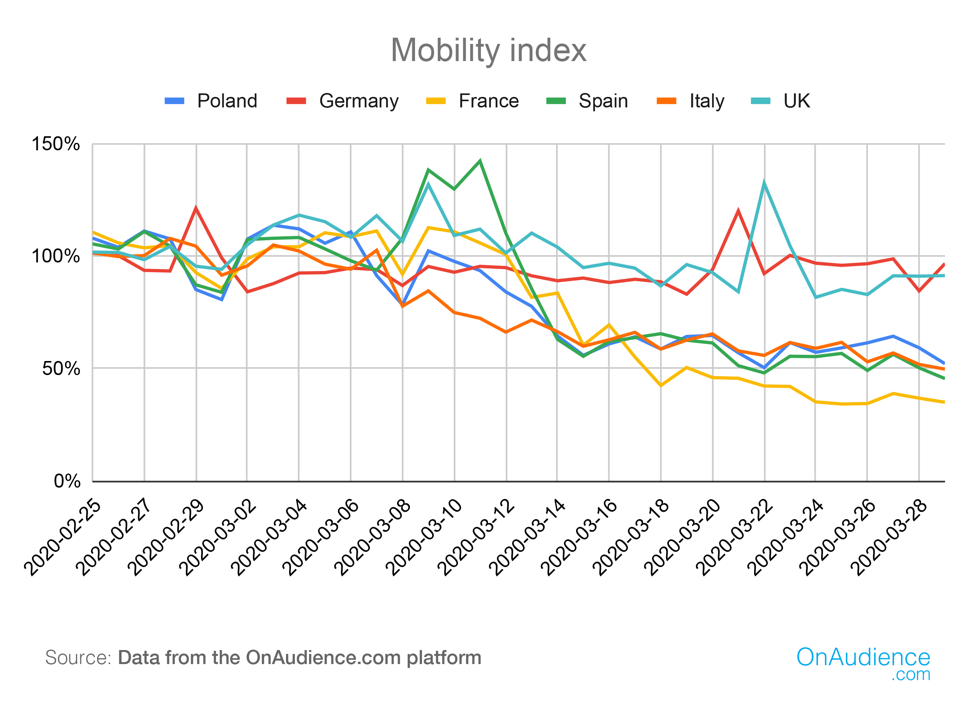Europe in Isolation: a New OnAudience.com Mobility Report
by on 3rd Apr 2020 in News


OnAudience.com, the London-based big data company that specialises in data analysis and digital marketing, has taken a closer look at the response of European citizens to the lockdown and self-quarantine measures imposed by their governments. Data experts tracked the behaviour of citizens of France, Spain, Germany, Poland, Italy and Great Britain to establish the extent to which European citizens are limiting their movement in their new mobility index.
Europe stays at home
With the World Health Organisation (WHO) calling for citizens to stay home to prevent the spread of coronavirus, governments around the globe have imposed new and varied legislation to ensure that this vital measure is taken. The restrictions on mobility across Europe are displayed on the map below; the intensity of the colour determines how restrictive each nation is being towards its citizens mobility.

The charts prepared show the average distance covered by a statistical citizen of a given country. The value of 100% represents the average daily distance made by citizens before the study was conducted, and the coloured line shows the current average distances covered by residents of each country every day. This enables an easy comparison of the level of activity before and during the study to be made.
As a part of this analysis, the distances were standardised before the countries were compared: this was due to the fact that average distances in individual countries differ significantly, being influenced by average distance between place of residence and workplace, or even climate and weather.
Whilst distances have been put on equal footing, each country's differing contexts mustn't be swept aside: “Political, social and economic changes strongly influence our mobility and that is why the situation in particular countries should be interpreted individually,” says OnAudience.com CEO, Maciek Sawa. He adds that “certain events and dates should also be taken into consideration” when assessing the results of the index.
What our findings tell us

As the chart above shows, French, Spanish, Italian, and Polish citizens limited their mobility far more than the Germans and Brits. It is worth mentioning that a significant decline in movement in France, Spain, and Poland occurred after the WHO officially labelled the outbreak a pandemic. The stages at which the virus first appeared in these countries appears to have had no bearing on the speed at which mobility was reduced: cases first appeared in France and Spain in January, whereas Poland’s first confirmed case was recorded in early March. In Italy, where the outbreak has been particularly severe, movement remained high until crucial restrictions were imposed on 7th March, according to the mobility indicator.
Among the countries studied, France saw the greatest reduction of average daily distance, although this fall did take time to occur. Limitations on mobility in Italy and Spain only appeared when the number of confirmed cases began to grow rapidly, and Britain was the last of the studied countries to implement restrictions, with a drop in movement only being observed over the last few weeks.
What to do now
Although the global pandemic is ongoing, we can attempt to assess how efficiently different governments and societies reacted to the outbreak. Only when the situation is stabilised and normality returns will we able to establish whether more could have been done.
At present, common consensus is that social distancing is our most effective weapon in the fight against COVID-19. “This method of fighting the virus refers to how to create a barrier of physical distance between two or more people. It allows us to prevent or even stop the virus transmission,” says Arindam Basu, professor of epidemiology and environmental health at the University of Canterbury in New Zealand. “At this time, there is no safe and effective vaccine, and we also do not know whether a safe and effective medicine would work after the symptoms of COVID-19 have already occurred. That is why the best thing to do for now is to prevent the virus from spreading.”
Methodology
To prepare the analysis, anonymous data from mobile devices, primarily mobile phones connected to the internet, was collected. The geolocation was determined based on the GPS system to ensure accuracy.
Currently, a total of 824 million devices connected to the Internet are analysed on the French, Spanish, German, Polish, Italian, and British markets. Data used for this study was collected between 25th February and 29th March 2020. All data was standardised so that different markets could be compared.








Follow ExchangeWire